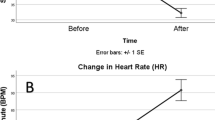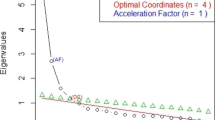Abstract
While anxiety research frequently uses only self-report measures to assess dimensions of state and trait anxiety, the present study sought to corroborate these self-report measures using a physiological measure, namely heart rate. Another aim of the present study was to test the multidimensional interaction model of anxiety in a social evalua-tion situation (i.e., a seminar presentation), using a physiological measure of state anxiety. Graduate psychology students completed a state anxiety questionnaire and were attached to a heart rate recorder prior to a class seminar presentation. One week later, students completed trait and state anxiety questionnaires and were again at-tached to a heart rate recorder prior to seminar observation by others. Heart rate was elevated during seminar presentation relative to seminar observation, reached maxi-mum values during the first 15 minutes of seminar presentation and then decreased over time. State anxiety scores indicate that participants were experiencing consider-ably more anxiety just before presenting the seminar than just before observing a seminar. Heart rate during seminar presentation was significantly correlated with self-report state anxiety and self-report social evaluation trait anxiety, but not with seminar grade. Support was found for the multidimensional interaction model of anxiety using the physiological measure (i.e., heart rate).
Similar content being viewed by others
References
Amoroso, D. M., & Walters, R. H. (1969). Effects of anxiety and socially mediated anxiety reduction on paired-associate learning. Journal of Personality and Social Psychology, 11, 388–396.
Bloom, L. J., & Trautt, G. M. (1977). Finger pulse volume as a measure of anxiety: Further evaluation. Psychophysiology, 14, 541–544.
Clements, K., & Turpin, G. (1996). Physiological effects of public speaking assessed using a measure of palmar sweating. Journal of Psychophysiology, 10, 283–290.
De Jong, M., Erdman, R. A. M., van den Brand, M. J. B. M., Verhage, F., Trusberg, R. W., & Passchier, J. (1994). Home measures of anxiety, avoidant coping and defence as predictors of anxiety, heart rate and skin conductance level just before invasive cardiovascular procedures. Journal of Psychosomatic Re-search, 38, 315–322.
Dew, K. H., Galassi, J. P., & Galassi, M. D. (1984). Math anxiety: Relation with situational test anxiety, performance, physiological arousal, and math avoidance behavior. Journal of Counseling Psychology, 31, 580–583.
Endler, N. S. (1983). Interactionism: A personality model, but not yet a theory. In M. M. Page (Ed.), Nebraska Symposium on Motivation 1982: Personality-Current theory and research, (pp. 155–200). Lincoln, NE: University of Nebraska Press.
Endler, N. S. (1997). Stress, anxiety and coping: The multidimensional interaction model. Canadian Psychology, 38, 136–153.
Endler, N. S., Edwards, J., & Vitelli, R. (1991). Endler Multidimensional Anxiety Scales: Manual. Los Angeles: Western Psychological Services.
Endler, N. S., Flett, G. L., Macrodimitris, S. D., Corace, K. M., & Kocovski, N. L. (2001). Separation, self-disclosure, and social-evaluation anxiety as facets of trait social anxiety. Manuscript submitted for publication.
Endler, N. S., Kantor, L., & Parker, J. D. A. (1994). State-trait coping, state-trait anxiety and academic performance. Personality and Individual Differences, 16, 663–670.
Flett, G. L., Endler, N. S., & Rector, N. A. (2001). Separation anxiety in adults: A review of conceptual, methodological, and empirical issues. Manuscript submitted for publication.
Fontana, A. M., Hyra, D., Godfrey, L., & Cermak, L. (1999). Impact of a peer-led stress inoculation training intervention on state anxiety and heart rate in college students. Journal of Applied Biobehavioral Research, 4, 45–63.
Kaufman, A. S., Eller, B. F., & Applegate, B. (1990). An investigation of somatic anxiety and intelligence in children using the Kaufman-ABC and an Apple IIe program measuring heart rate. Perceptual and Motor Skills, 70, 387–394.
Magnusson, D., & Endler, N. S. (1977). Interaction psychology: Present status and future prospects. In D. Magnusson & N. S. Endler (Eds.), Personality at the crossroads: Current issues in interactional psy-chology (pp. 3–31). Hillsdale, NJ: Lawrence Erlbaum.
Martin, B. The assessment of anxiety by physiological behavioral measures. Psychological Bulletin, 58, 234-255.
Morrow, G. R., & Labrum, A. H. (1978). The relationship between psychological and physiological measures of anxiety. Psychological Medicine, 8, 95–101.
Smith, T. W., Houston, B. K., & Zurawski, R. M. (1984). Finger pulse volume as a measure of anxiety in response to evaluative threat. Psychophysiology, 21, 260–264.
Spielberger, C. D. (1966). The effects of anxiety on complex learning and academic achievement. In C. D. Spielberger (Ed.), Anxiety and behavior (pp. 361–398). New York: Academic Press.
Tenenbaum, G., & Milgram, R. M. (1978). Trait and state anxiety in Israeli student athletes. Journal of Clinical Psychology, 34, 691–693.
Trotter, M., & Endler, N. S. (1999). An empirical test of the interaction model of anxiety in a competitive equestrian setting. Personality and Individual Differences, 27, 861–875.
Walters, R. H., & Parke, R. D. (1964). Social motivation, dependency, and susceptibility to social influ-ence. In L. Berkowitz (Ed.), Advances in experimental and social psychology (v. 1). New York: Aca-demic Press.
Author information
Authors and Affiliations
Rights and permissions
About this article
Cite this article
Kantor, L., Endler, N.S., Heslegrave, R.J. et al. Validating self-report measures of state and trait anxiety against a physiological measure. Curr Psychol 20, 207–215 (2001). https://doi.org/10.1007/s12144-001-1007-2
Accepted:
Issue Date:
DOI: https://doi.org/10.1007/s12144-001-1007-2




